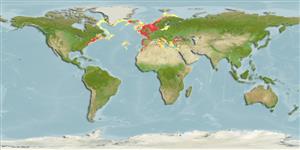Classificação / Names
Common names from other countries
Referência principal
Tamanho / Peso / Idade
Max length : 60.0 cm FL macho/indeterminado; (Ref. 35388); common length : 30.0 cm FL macho/indeterminado; (Ref. 168); Peso máx. publicado: 3.4 kg (Ref. 9988); Idade máx. registada: 17 anos (Ref. 207)
Length at first maturity
Lm 28.7, range 34 - ? cm
Ambiente
; marinhas; estuarina; oceanódromos (Ref. 51243); intervalo de profundidade 0 - 1000 m (Ref. 54254), usually 0 - 200 m (Ref. 54254)
Clima / Intervalo
Temperate, preferred 10°C (Ref. 107945); 70°N - 25°N, 77°W - 42°E
Distribuição
Descrição suscinta
Espinhos dorsais (total): 8 - 14; Raios dorsais (total): 113; Espinhos anais 1; Raios anais : 12 - 13; Vértebras: 31. This species has the following characters: no well developed corselet; interpelvic process small and single; anal fin spine conspicuous, joined to the fin by a membrane but clearly independent of it; anal fin origin opposite that of second dorsal fin; no swim bladder; first haemal spine anterior to first interneural process; 21-28 interneural bones under first dorsal fin; markings on back oblique to near vertical, with relatively little undulating; belly unmarked (Ref. 168).
Status na Lista Vermelha da IUCN (Ref. 115185)
Perigo para os humanos
Harmless
Uso pelos humanos
Pescarias: altamente comercial; peixe esportivo: sim
Ferramentas
Relatórios especiais
Baixar XML
Fontes da internet
Estimates of some properties based on models
Phylogenetic diversity index
PD50 = 0.5625 many relatives (e.g. carps) 0.5 - 2.0 few relatives (e.g. lungfishes)
Nível Trófico
3.6 ±0.2 se; Based on diet studies.
Resiliência
Médio, tempo mínimo de duplicação da população 1,4 - 4,4 anos (rm=0.33-0.56; K=0.23-0.27; tm=2-3; tmax=17; Fec=200,000)
Vulnerabilidade
Moderate vulnerability (44 of 100)
Categoria de preço
